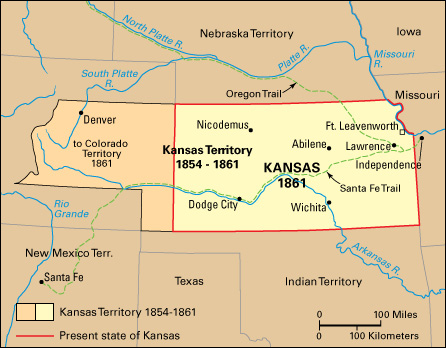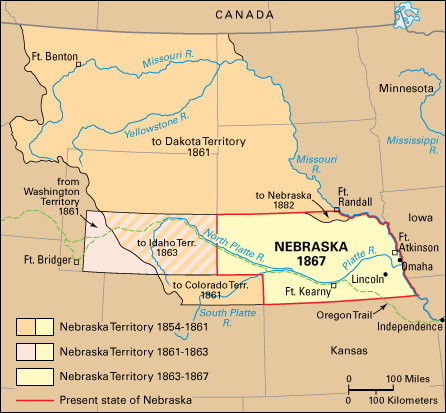Bleeding Kansas refers to a period of violence between proslavery and antislavery groups in Kansas and Missouri before the American Civil War (1861-1865). The conflict involved the question of whether the Kansas Territory would be admitted to the Union as a free state or slave state. More than 50 people were killed in the conflict, and much property was destroyed. The “Bleeding Kansas” conflict is sometimes called the Border War.
Background.
In 1854, the United States Congress passed the Kansas-Nebraska Act, which established the territories of Kansas and Nebraska. The act included a controversial provision for “popular sovereignty.” This provision stated that all questions of slavery in the new territories were to be decided by the settlers rather than by Congress.

Settlers from both the North and South soon were streaming into Kansas, and a number of groups wanted to influence the decision on slavery. Antislavery Kansans formed the Free State party. In the elections of 1855, many citizens of the slave state of Missouri crossed the border and voted in Kansas. Proslavery candidates won control of the territorial legislature and passed many proslavery laws.

The Border War.
Violence soon broke out, particularly in the area near the Kansas-Missouri border. On May 21, 1856, supporters of slavery burned part of the town of Lawrence, Kansas, which was a Free State stronghold. Three days later, a party led by abolitionist John Brown rounded up five proslavery settlers near Pottawatomie Creek, in east-central Kansas, and killed them.
In total, more than 50 people died in various small battles of this period. The violence in Kansas over the slavery issue attracted national attention. Newspaper reports coined the phrase “Bleeding Kansas.”
Proslavery legislators in Kansas wrote a constitution favoring slavery, but Kansas voters rejected it. The Free State party later gained control of the legislature. In 1859, voters approved a constitution forbidding slavery and asked the U.S. Congress for statehood. Many Southerners opposed the idea of admitting Kansas as a free state. Nonetheless, Kansas became the 34th state on Jan. 29, 1861, after several Southern states had left the Union.
The Civil War.
Regional fighting over slavery increased after the Civil War began in April 1861. Missouri stayed in the Union but remained a slave state. Antislavery leaders Charles R. “Doc” Jennison and James Henry Lane led “jayhawking” raids into Missouri. The raiders attacked slaveholders and brought back freed slaves. Confederate guerrillas conducted raids against Kansas and Missouri farmers and townspeople who favored the Union. On Aug. 21, 1863, Confederate raiders under William Clarke Quantrill burned most of Lawrence and killed about 150 people. The famous Missouri outlaws Frank and Jesse James joined in several anti-Union raids.
Later years.
Rivalries between Kansans and Missourians continued after the Civil War ended. Kansans adopted the nickname Jayhawkers from the antislavery raiders of the “Bleeding Kansas” era.
The Kansas-Missouri rivalry soon influenced college sports. Athletic teams from the University of Kansas, based in Lawrence, became known as the Jayhawks. Teams from the University of Missouri became the Tigers. That name came from a Union “home guard” militia (citizen army) regiment that protected Columbia, Missouri, from Confederate fighters. Competitions between the rival schools became known as “Border Wars.”
See also Brown, John ; Kansas (History) ; Kansas-Nebraska Act ; Missouri (History) ; Quantrill, William Clarke .
